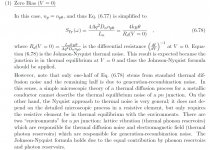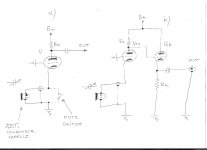Well Rutgers is nothing if not enthusiastic. But starting out with an op amp as the first device in the signal chain is hardly the way to go, bootstrapped or not. His discussion of variable input capacitance in JFETs as a way of dismissing them is silly, and as Scott says he's apparently not seen the second article in LA.
billshurv, I was just asking the question: Who. Now, yiou gave me the answer, and I can agree, of course.Remember you are the one generally telling us to be open minded 😛
On the second part of my message, i precised It was just MY point of view: Mikes are for me like musical instruments.
Btw: Apart little electrets, usually sold in sealed capsule with their FET inside, where can I find those 5£ capsules you are talking-to (really interested) ?
he's apparently not seen the second article in LA.
Vol. 3, fig. 10 is a way to bootstrap a cheap capsule with internal JFET with only an npn and pnp, and fig. 11 is the one FET and low noise bipolar SS op-amp version that does 8V p-p off of a 9V battery by using capacitive bootstrapping that can go outside the rails.
Both eliminate capacitance modulation.
I first thought, reading its comments five minutes ago: "Oh, Lord, what can be the influence of the FET input capacitance, once paralleled with the mic capsule's one ?"His discussion of variable input capacitance in JFETs as a way of dismissing them is silly.
billshurv, I was just asking the question: Who. Now, yiou gave me the answer, and I can agree, of course.
On the second part of my message, i precised It was just MY point of view: Mikes are for me like musical instruments.
Btw: Apart little electrets, usually sold in sealed capsule with their FET inside, where can I find those 5£ capsules you are talking-to (really interested) ?
JLI - Search Results for "mic"
Call Mark directly to decode the sometimes cryptic schematics (it's not always clear what are the ones without FET's).
The 16mm and 25mm ones are what you want, some much less than a fiver.
I seem to remember that the equiv. resistance of a junction has only half-thermal noise,
as if the resistor was at 150 Kelvin typ. Must search the text book.
Gerhard
Attachments
Sinatra agreed with you.Mikes are for me like musical instruments.
What text is that from Scott? Looks authoritative 🙂
New link (the one in my article is dead).
http://www.nii.ac.jp/qis/first-quantum/forStudents/lecture/pdf/noise/chapter6.pdf
Thanks.New link (the one in my article is dead).
http://www.nii.ac.jp/qis/first-quantum/forStudents/lecture/pdf/noise/chapter6.pdf
Very interesting remarks about the sub-shot noise of emitted photons on page 31, referencing Yamamoto.
Because of charge-pumping effects (as opposed to mere displacement currents) in the Reticon arrays, of opposing polarity to the anticipated photon-induced charge signals, and because my pulsed-reset preamp could only reset for one polarity, I had to puff some photons on the array from an LED. It's interesting to know that the ~80k photons didn't degrade the noise quite as much as I thought they must have (assuming full shot noise).
billshurv, I was just asking the question: Who. Now, yiou gave me the answer, and I can agree, of course.
On the second part of my message, i precised It was just MY point of view: Mikes are for me like musical instruments.
Btw: Apart little electrets, usually sold in sealed capsule with their FET inside, where can I find those 5£ capsules you are talking-to (really interested) ?
We are in violent agreement. I know microphones are the tools of your trade 🙂
TSB-165A
🙂TSB-165A
I used 3 very little omni electret capsules. As they were damn flat, one for measuring instrument, and the two others hidden in a thermo-retractable envelope that i used around my head, fixed on my glasses branches at the top of my head.
It made an artificial head that i used during movies or documentary recordings to catch stereo ambiances with (at this time) a mini portable mini disk in my pocket. It was fantastic: Nobody had never noticed I was recording them, and sounded damn good ;-)
Thanks a lot Scott. "Si vous n'existiez pas, il faudrait vous inventer".The 16mm and 25mm ones are what you want, some much less than a fiver.
Scott,
We really don't communicate. The first large scale use was in WWII by the Japanese. The first mics were much earlier. Some cites say 1928.
ES
Come on Ed you're stretching to make a point. An issued patent would be an easy Wikipedia reference that anyone can find, has no controversy, and predates 1962.
Long time ago , 30 years or so I made this electret capsule tube pre . , it works like charm ,
no any hum or noise , no any negative RF interference , I use this combination for years in my little studio for my AM pirate radio .
This simple tube mic pre. don`t ask for any regulated PSU at all , B+ was around 250VDC or so ,grounded grid tube was 1/2 of Ecc83 , Ra was around 100K , cheap and small electret capsule was with integrated NJFET unit .
no any hum or noise , no any negative RF interference , I use this combination for years in my little studio for my AM pirate radio .
This simple tube mic pre. don`t ask for any regulated PSU at all , B+ was around 250VDC or so ,grounded grid tube was 1/2 of Ecc83 , Ra was around 100K , cheap and small electret capsule was with integrated NJFET unit .
Attachments
Interesting, it ran off the cathode current of the tube. Was that luck or design?
Have you ever measured the cathode voltage of the first stage while the mic was on?
-Chris
Have you ever measured the cathode voltage of the first stage while the mic was on?
-Chris
Interesting, it ran off the cathode current of the tube. Was that luck or design?
Have you ever measured the cathode voltage of the first stage while the mic was on?
-Chris
Hi Chris !
Story of this my design is very simple ,
after I had big stability problems with Shure 558 to work properly in high RF field of my relative powerfull AM tube transmitter (~0,5KW) I start to look for some better solution , so I start to experiment with one cheap electret capsule ,
first I try to connect capsule output conventionally in tube grid ,
result was even worse than with Shure ,
than I connected this capsule directly on tube cathode by tying the grid to the ground line and Bingo ! , it works and sounds like charm ! ,
but must admit that even today I never made any measurements ,I think why to measure something if that already works and sounds very good 🙂 .
Later and even today many others of my AM pirate friends uses this simple tube mic pre. to .
Last edited:
Hi banat,
I love what you put together. It's so elegant and simple.
I'm just wondering about how much voltage drop the mic is seeing, and where the 12AX7A is on it's curve. It's not about quality, but it would be neat to see how this balanced itself. I'm guessing other tube types with higher cathode current might not work, or they might damage the mic.
Just for chuckles and grins, you should measure this. You might get a useful indicator as to the health of the tube. What you put together makes perfect sense in an RF environment. What's even cooler is that I think I just met my first pirate!
-Chris
I love what you put together. It's so elegant and simple.
I'm just wondering about how much voltage drop the mic is seeing, and where the 12AX7A is on it's curve. It's not about quality, but it would be neat to see how this balanced itself. I'm guessing other tube types with higher cathode current might not work, or they might damage the mic.
Just for chuckles and grins, you should measure this. You might get a useful indicator as to the health of the tube. What you put together makes perfect sense in an RF environment. What's even cooler is that I think I just met my first pirate!
-Chris
Interesting, it ran off the cathode current of the tube. Was that luck or design?
Have you ever measured the cathode voltage of the first stage while the mic was on?
-Chris
This is no problem at all, the + terminal of the capsule is the drain of the FET so simple cascode and both capsule and tube run at Idss of the FET. The tube could be replaced by a high Vp FET with gate grounded and it would work fine too.
- Status
- Not open for further replies.
- Home
- Member Areas
- The Lounge
- John Curl's Blowtorch preamplifier part II

